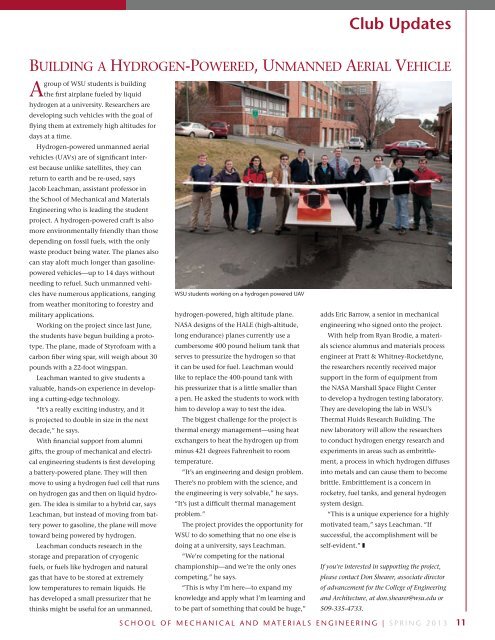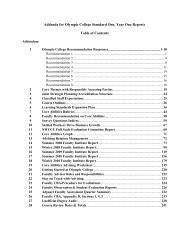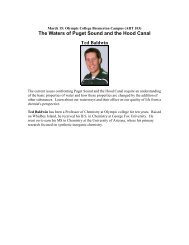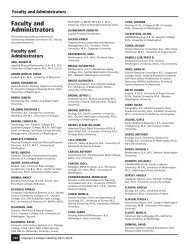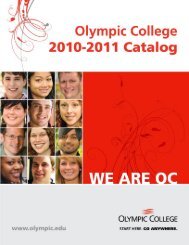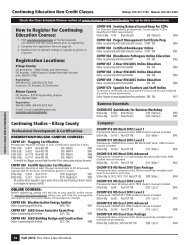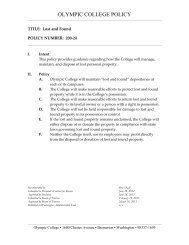Full MME Newsletter - Washington State University College of ...
Full MME Newsletter - Washington State University College of ...
Full MME Newsletter - Washington State University College of ...
You also want an ePaper? Increase the reach of your titles
YUMPU automatically turns print PDFs into web optimized ePapers that Google loves.
Club Updates<br />
Building a Hydrogen-Powered, Unmanned Aerial Vehicle<br />
group <strong>of</strong> WSU students is building<br />
A the first airplane fueled by liquid<br />
hydrogen at a university. Researchers are<br />
developing such vehicles with the goal <strong>of</strong><br />
flying them at extremely high altitudes for<br />
days at a time.<br />
Hydrogen-powered unmanned aerial<br />
vehicles (UAVs) are <strong>of</strong> significant interest<br />
because unlike satellites, they can<br />
return to earth and be re-used, says<br />
Jacob Leachman, assistant pr<strong>of</strong>essor in<br />
the School <strong>of</strong> Mechanical and Materials<br />
Engineering who is leading the student<br />
project. A hydrogen-powered craft is also<br />
more environmentally friendly than those<br />
depending on fossil fuels, with the only<br />
waste product being water. The planes also<br />
can stay al<strong>of</strong>t much longer than gasolinepowered<br />
vehicles—up to 14 days without<br />
needing to refuel. Such unmanned vehicles<br />
have numerous applications, ranging<br />
from weather monitoring to forestry and<br />
military applications.<br />
Working on the project since last June,<br />
the students have begun building a prototype.<br />
The plane, made <strong>of</strong> Styr<strong>of</strong>oam with a<br />
carbon fiber wing spar, will weigh about 30<br />
pounds with a 22-foot wingspan.<br />
Leachman wanted to give students a<br />
valuable, hands-on experience in developing<br />
a cutting-edge technology.<br />
“It’s a really exciting industry, and it<br />
is projected to double in size in the next<br />
decade,” he says.<br />
With financial support from alumni<br />
gifts, the group <strong>of</strong> mechanical and electrical<br />
engineering students is first developing<br />
a battery-powered plane. They will then<br />
move to using a hydrogen fuel cell that runs<br />
on hydrogen gas and then on liquid hydrogen.<br />
The idea is similar to a hybrid car, says<br />
Leachman, but instead <strong>of</strong> moving from battery<br />
power to gasoline, the plane will move<br />
toward being powered by hydrogen.<br />
Leachman conducts research in the<br />
storage and preparation <strong>of</strong> cryogenic<br />
fuels, or fuels like hydrogen and natural<br />
gas that have to be stored at extremely<br />
low temperatures to remain liquids. He<br />
has developed a small pressurizer that he<br />
thinks might be useful for an unmanned,<br />
WSU students working on a hydrogen powered UAV<br />
hydrogen-powered, high altitude plane.<br />
NASA designs <strong>of</strong> the HALE (high-altitude,<br />
long endurance) planes currently use a<br />
cumbersome 400 pound helium tank that<br />
serves to pressurize the hydrogen so that<br />
it can be used for fuel. Leachman would<br />
like to replace the 400-pound tank with<br />
his pressurizer that is a little smaller than<br />
a pen. He asked the students to work with<br />
him to develop a way to test the idea.<br />
The biggest challenge for the project is<br />
thermal energy management—using heat<br />
exchangers to heat the hydrogen up from<br />
minus 421 degrees Fahrenheit to room<br />
temperature.<br />
“It’s an engineering and design problem.<br />
There’s no problem with the science, and<br />
the engineering is very solvable,” he says.<br />
“It’s just a difficult thermal management<br />
problem.”<br />
The project provides the opportunity for<br />
WSU to do something that no one else is<br />
doing at a university, says Leachman.<br />
“We’re competing for the national<br />
championship—and we’re the only ones<br />
competing,” he says.<br />
“This is why I’m here—to expand my<br />
knowledge and apply what I’m learning and<br />
to be part <strong>of</strong> something that could be huge,”<br />
adds Eric Barrow, a senior in mechanical<br />
engineering who signed onto the project.<br />
With help from Ryan Brodie, a materials<br />
science alumnus and materials process<br />
engineer at Pratt & Whitney-Rocketdyne,<br />
the researchers recently received major<br />
support in the form <strong>of</strong> equipment from<br />
the NASA Marshall Space Flight Center<br />
to develop a hydrogen testing laboratory.<br />
They are developing the lab in WSU’s<br />
Thermal Fluids Research Building. The<br />
new laboratory will allow the researchers<br />
to conduct hydrogen energy research and<br />
experiments in areas such as embrittlement,<br />
a process in which hydrogen diffuses<br />
into metals and can cause them to become<br />
brittle. Embrittlement is a concern in<br />
rocketry, fuel tanks, and general hydrogen<br />
system design.<br />
“This is a unique experience for a highly<br />
motivated team,” says Leachman. “If<br />
successful, the accomplishment will be<br />
self-evident.” ❚<br />
If you’re interested in supporting the project,<br />
please contact Don Shearer, associate director<br />
<strong>of</strong> advancement for the <strong>College</strong> <strong>of</strong> Engineering<br />
and Architecture, at don.shearer@wsu.edu or<br />
509-335-4733.<br />
School <strong>of</strong> Mechanical and Materials Engineering | Spring 2013 11


